Table of Contents
In the Software Asset Management (SAM) space, there’s a sentiment that looking too closely at Software as a Service (SaaS) could unleash too many complexities. A cautious SAM professional might treat it like opening Pandora’s box. They dread discovering a thousand new SaaS applications, each presenting its own set of challenges.
This apprehension is understandable, especially for those rooted in traditional software management methodologies. But don’t let a “status quo” mindset hold you back from a great SAM opportunity. It’s time to address the elephant in the room and explore the need for a paradigm shift. By clinging to old-school practices, the modern SaaS manager risks falling further behind in an ever-evolving digital landscape.
This article will debunk ten common misconceptions about SaaS Management. More importantly, we’ll highlight the transformative potential of embracing this new era of software management. While it might represent uncharted territory for you, it’s also a chance to drive meaningful change for your organization and propel your career to new heights.
Myth #1: SaaS Is in the Cloud, So You Don’t Need to Manage It
Debunking the Software Asset Management Myth
One prevailing misconception surrounding SaaS is that once deployed in the cloud, it requires minimal to no management. The truth is, proactive management is more than just beneficial — it’s imperative for optimal utilization and cost-effectiveness.
Your business’s needs are dynamic, and the efficacy of SaaS tools can vary over time. A solution that once seemed indispensable might become redundant, or your organization’s requirements might outgrow its capabilities. That’s why proactively managing SaaS costs and usage is essential to aligning your investments with evolving business objectives.
Taking Control of Your Investment
While SaaS vendors have visibility into your usage patterns, you ultimately have the onus of maximizing the value of your investment. Your vendors may provide insights, but it’s your understanding of your business’s unique needs that enables you to make informed decisions. Only you can determine which tools best align with your strategic objectives—but only if you have all the data. Learn how to build the case for SaaS Management here.
Myth# 2: You Can Manage SaaS the Same As On-Premises Software
Debunking the Software Asset Management Myth
Another common misconception surrounding SaaS Management is the belief that you can approach it the same way as traditional on-premises software. While the principles of managing on-premises software often revolve around audit preparation and effective license positioning (ELP), the nature of SaaS Management requires a different mindset.
Unlike on-premises software, which often follows a structured process centered around ELP and audit readiness, SaaS Management requires ongoing optimization. SaaS’s dynamic nature and ever-changing business needs demands agility, necessitating a shift from rigid processes to adaptive strategies.
Embracing Agility and Collaboration
Managing SaaS effectively means being agile and responsive to changing requirements. It’s about continuous optimization rather than one-time audit prep. Collaboration with organizational stakeholders becomes a priority since SaaS impacts various departments. By fostering collaboration and adaptability, organizations can harness the full potential of their SaaS investments.
Myth #3: Using A Traditional Software Asset Management Tool Works for SaaS
Debunking the Software Asset Management Myth
Many believe traditional Software Asset Management (SAM) tools are sufficient for managing SaaS applications. However, relying solely on these tools can lead to inefficiencies and inaccuracies in SaaS Management.
Despite the widespread belief among IT and SAM leaders (70%) that their current SaaS tracking methods are accurate, the reality is quite different. According to the 2025 SaaS Management Index, three out of four organizations still use fallible legacy tools or spreadsheets. This discrepancy highlights a critical gap between perception and reality in SaaS Management practices.
The Need for Both A SAM Tool and SaaS Management Platform
While effective for managing traditional on-premises software, SAM tools are ill-suited for SaaS’s dynamic nature. They lack the capabilities to support holistic SaaS Management practices, such as real-time inventory tracking, license optimization, and renewal management.
To effectively manage SaaS applications, organizations need a purpose-built SaaS Management Platform (SMP). These platforms address the key pillars of SaaS Management: inventory, license, and renewal management. By centralizing SaaS Management processes within an SMP, organizations can gain better visibility, control, and optimization of their SaaS investments.
Managing software in today’s digital landscape necessitates a dual approach. While a SAM tool remains essential for managing traditional software assets, you also need an SMP to manage SaaS applications effectively. Organizations can ensure comprehensive software management across all deployment models by leveraging both SAM and SMP solutions.
“On-premises software tools don’t give you the SaaS Management and SaaS visibility that you need. You can’t run with just one tool in the software asset management space.”
– Jason Owens, Senior Director, Asset Management at Salesforce
Myth #4: SaaS Applications Are IT’s Domain
Debunking the Software Asset Management Myth
Some think that SaaS applications fall squarely within the realm of IT or software asset management. However, the landscape of SaaS adoption has evolved with decentralized purchasing, leading to IT departments losing oversight and control.
Decentralized purchasing has resulted in a significant shift in SaaS ownership within organizations. Business units now wield considerable influence and are responsible for a substantial portion of SaaS spending and application quantity. Additionally, individual employees contribute to SaaS adoption with shadow IT, further complicating the landscape.
The Importance of Visibility & Empowering Collaboration
Organizations must have visibility into all their SaaS applications to manage SaaS sprawl, contain costs, maximize license utilization, and mitigate security and compliance risks. Without comprehensive visibility, IT departments struggle to maintain control and address the challenges of decentralized purchasing.
Addressing the reality of decentralized SaaS purchasing requires a collaborative approach between IT/SAM and business units. Organizations can establish governance frameworks that balance agility and control by fostering communication and collaboration. Doing so ensures that SaaS investments align with business objectives while mitigating financial and security risks for the organization.
Myth #5: Your Top 15 Applications Are the Only Ones That Matter
Debunking the Software Asset Management Myth
While core enterprise applications are critical to business operations, overlooking long-tail applications can lead to missed opportunities and increased risks.
According to the 2025 SaaS Management Index, nearly 74% of spend and 84% of applications are owned by lines of business and employees. Ignoring these applications means disregarding valuable opportunities to optimize costs, mitigate risks, and streamline operations.
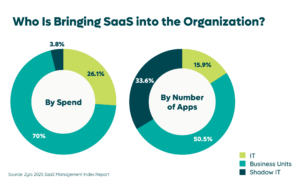
Managing SaaS fully means:
- Cost Reduction: Organizations can reduce software footprint and associated costs by identifying underutilized or redundant applications.
- Cost Avoidance: Proactively managing user licenses can help avoid unnecessary expenses by deprovisioning or downgrading licenses when appropriate.
- Risk Mitigation: Identifying potentially risky software within long-tail apps allows organizations to address security and compliance concerns before they escalate.
- Standardization and Efficiency: Eliminating redundancies and standardizing applications across the enterprise enhances efficiency and reduces complexity.
Embracing a Holistic Approach
Organizations must adopt a holistic methodology encompassing core enterprise and long-tail applications to effectively manage their SaaS portfolio. By doing so, they can optimize costs, mitigate risks, and drive operational efficiency across their software landscape.
Myth #6: It’s Impossible to Manage Hundreds of Software Titles
Debunking the Software Asset Management Myth
Managing numerous SaaS titles may seem daunting at first glance. However, the notion that it’s impossible to manage effectively is a misconception that fails to consider the benefits of the right SaaS Management platform.
The average enterprise has a staggering 660 SaaS applications in its tech stack, adding up to $284M in annual spending. While this volume may seem overwhelming, remember – not all applications require the same level of management or priority.
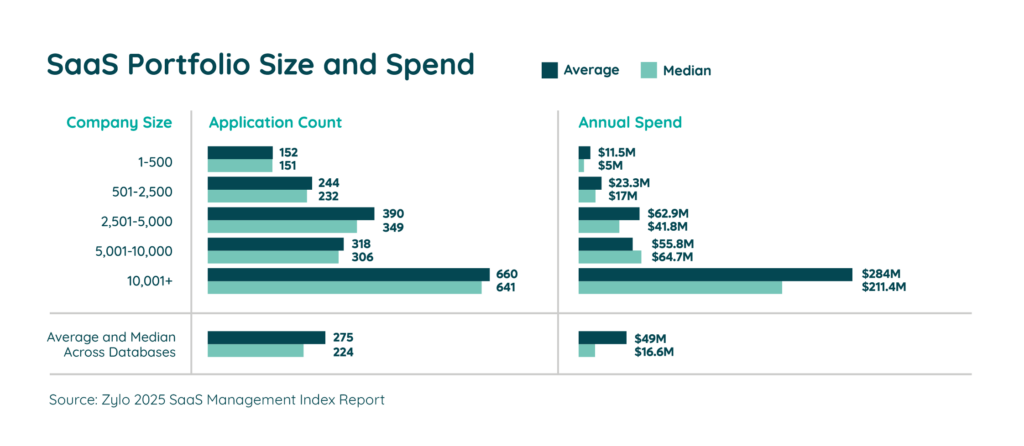
Prioritization and Scalability
Unlike on-premises software, not all SaaS applications need management at the same complexity level. An effective SaaS Management program adopts a tiered approach, prioritizing top-level enterprise applications for full support and management. These “short-tail” applications are critical to running the business, integrate with multiple systems, and represent the highest area of spend.
Meanwhile, other applications within the SaaS portfolio can be supported based on their complexity and criticality to the business. By scaling support and management efforts, organizations can allocate resources more efficiently and focus on maximizing the value of their investments.
Myth #7: Enterprises Always Have Their Licensing in Order
Debunking the Software Asset Management Myth
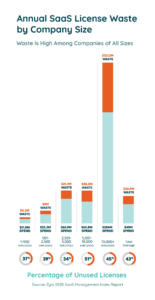 We’d all like to think that large enterprises, with their ample resources, stay on top of their software licenses. However, the data reveals the opposite: enterprises often struggle to maintain control over their licensing agreements, leading to substantial waste and inefficiencies.
We’d all like to think that large enterprises, with their ample resources, stay on top of their software licenses. However, the data reveals the opposite: enterprises often struggle to maintain control over their licensing agreements, leading to substantial waste and inefficiencies.
Despite the assumption that enterprises have their licensing in order, enterprises typically utilize only 45% of their provisioned licenses, compared to the overall average of 47% utilization. This discrepancy translates to a staggering $127.3M in license waste annually.
Navigating the Complexity
The scale of the SaaS portfolio within enterprises and the complexities of licensing across various departments and global locations present significant challenges. Managing licenses in such a dynamic environment requires a comprehensive understanding of usage patterns, contractual agreements, and evolving business needs.
Traditionally, license management in the software realm centered around preparing for audits and avoiding true-ups. However, in today’s landscape, it’s about more than just compliance—organizations must maximize the value of existing licenses and optimize them to meet evolving business needs.
Myth #8: Security Is the SaaS Vendor’s Responsibility
Debunking the Software Asset Management Myth
It’s tempting to think that security management in SaaS applications is solely the vendor’s responsibility. However, in today’s threat landscape, enterprises must proactively mitigate risks and safeguard their data. After all, it is your and your customers’ data in those tools.
Cybersecurity is paramount in the digital age. While you can’t prevent a data breach, enterprises must manage what is in their control. That means understanding what potential risks lurk in their SaaS ecosystem and taking the right actions to stay ahead of them.
Taking Control of Unmanaged Risks
Despite the assumption that SaaS vendors handle security, data indicates otherwise. A startling 68% of expensed applications carry a “Poor” or “Low” risk score, highlighting significant unmanaged risk within the software landscape. Ignoring these risks can have severe consequences.
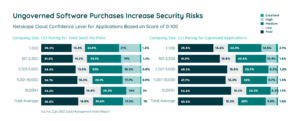
The repercussions of security breaches are financially and reputationally severe. According to an IBM study, data breaches cost an average of $4.88M, not to mention the erosion of customer trust and damage to the organization’s reputation. Plus, noncompliance with regulations can result in hefty fines and penalties.
Enterprises must take an active role in securing their SaaS applications. This involves conducting regular assessments of their SaaS portfolio, implementing robust security measures, and ensuring compliance with regulations. By assuming responsibility for security, enterprises can better protect their data, mitigate risks, and safeguard their reputation.
Myth #9: Software Asset Management Has Nothing To Do with IT or Procurement
Debunking the Software Asset Management Myth
This is one of the most detrimental myths to SaaS Management effectiveness. In reality, SaaS Management thrives on cross-collaboration between SAM, IT, and Procurement teams.
SaaS Management is a team sport that requires seamless collaboration among organization stakeholders. SAM, IT, and Procurement teams share common objectives, including reducing operating expenses, enhancing efficiency, and mitigating risks. Working together, these teams can leverage their collective expertise to achieve their shared goals.
Cross-Functional Alignment for Shared Success
SAM, IT, and Procurement teams are all working toward the same objectives. Yet, they often operate in silos, leading to inefficiencies and missed opportunities. By recognizing their interdependencies and working together as a unit, they can streamline processes, identify cost-saving opportunities, and mitigate risks more effectively. In doing so, they contribute to the organization’s overall success and resilience. It also allows organizations to better optimize their SaaS Management practices and maximize the value of their software investments.
Myth #10: SaaS Management Will Kill Your Career
Debunking the Software Asset Management Myth
Embracing SaaS Management won’t spell doom for your career. In fact, it presents a golden opportunity to become a changemaker within your organization—a SaaS-y superhero, if you will—ushering in a new era of efficiency and innovation.
SaaS has become integral to modern business operations and shows no signs of slowing down. According to IDC, the market has ballooned to over $205 billion since 2008, with spending on SaaS surpassing on-premises software. This shift underscores the critical importance of SaaS Management in today’s digital landscape.
Embracing Change and Innovation
Managing SaaS effectively requires deviating from traditional software management practices. It’s an opportunity to challenge the status quo, drive meaningful change, and position yourself as a leader in your organization’s digital transformation journey. By embracing SaaS Management, you become a catalyst for innovation, efficiency, and success.
Far from being detrimental to your career, mastering SaaS Management can propel you to new professional heights. Implementing tools and strategies for cost optimization, usage tracking, and compliance benefits the organization and showcases your expertise and leadership. These wins serve as tangible evidence of your value and can catapult your career forward.
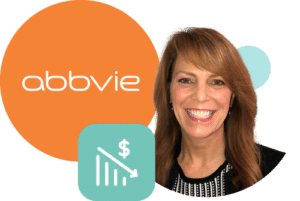 Renee Turco, Technology Asset Manager at AbbVie, sees SaaS Management as a chance to help the business drive better decision-making. As she sees it, the opportunity is “being able to turn a lot of broad data and information into a cost and applicable business story.” Then, “taking that information back to your business to add value and be more proactive with them.”
Renee Turco, Technology Asset Manager at AbbVie, sees SaaS Management as a chance to help the business drive better decision-making. As she sees it, the opportunity is “being able to turn a lot of broad data and information into a cost and applicable business story.” Then, “taking that information back to your business to add value and be more proactive with them.”
Take a deeper dive into SaaS Management and why it’s important, and see firsthand what a framework for an effective program looks like. Or, see how a tool like Zylo can help by taking a tour here.



 – Jason Owens, Senior Director, Asset Management at Salesforce
– Jason Owens, Senior Director, Asset Management at Salesforce